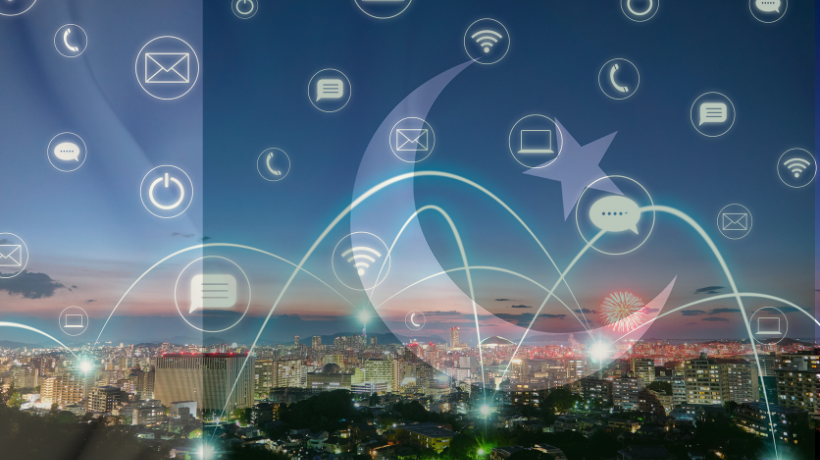Pakistan’s internet infrastructure is under strain with just two operators, Pakistan Telecommunication Company Limited (PTCL) and Transworld Associates (TWA), controlling the country’s gateways to global connectivity while the third, Cybernet, has just entered the competition.
The Wireless and Internet Service Providers Association of Pakistan (WISPAP) has raised concerns over this near-duopoly, warning that it is driving up costs, limiting competition, and slowing internet speeds compared to the rest of the world.
Chairman of WISPAP Shahzad Arshad describes the situation as a “structural crisis” that is preventing Pakistan from achieving its full digital potential. With over 140 million internet users, the country depends on undersea fiber-optic cables landing in Karachi. These cables, including PEACE and SEA-ME-WE-5, connect Pakistan to global data networks.
However, since only PTCL and TWA control access to these networks, smaller internet service providers (ISPs) have no choice but to buy bandwidth at high rates, often pegged to the US dollar.
This pricing structure has caused some big problems.
Power Concentrates, Prices Soar
Here’s the rub: PTCL, a state-linked titan, and TWA, a private operator, form a near-duopoly. PTCL has its fingers in most of the cables landing in Karachi, while TWA runs its own line, TW1.
Together, they dictate the terms—and the price—for every byte of data entering or leaving Pakistan. Smaller ISPs, the ones serving homes and businesses, have no choice but to buy bandwidth from these two, often at rates pegged to the US dollar.
“When the rupee tanks, our costs explode,” Arshad explains. “In 2024 alone, ISPs saw margins shrink by 25% due to currency swings, yet PTCL and TWA keep hiking rates. It’s a rigged game.”
Globally, this isn’t the norm. Take Singapore: it hosts over a dozen international cables and multiple Operators like Singtel and StarHub compete fiercely, driving down costs. Pakistan’s two-player system, by contrast, lacks that rivalry.
PTCL and TWA pay international cable consortia—think groups behind cables like AAE-1—millions annually for bandwidth, a cost they pass on with a hefty markup. Industry whispers peg these payments at $15 million to $60 million per operator, depending on capacity, with repair bills adding thousands more per incident. Smaller ISPs, and ultimately users, foot the bill.
The fallout? Pakistan’s internet ranks among South Asia’s most expensive per megabit, while speeds limp at 20-30 Mbps on average—dwarfed by Bangladesh’s 50 Mbps at half the price. “We’re paying champagne rates for tap water service,” Arshad quips.
When Gateways Fail, Pakistan Falters
Beyond cost, there’s vulnerability. With all traffic routed through Karachi, a single hiccup—like a cable snag in 2023 that slashed speeds by 40%, can paralyze the nation. Compare this to Indonesia, an archipelago with gateways in Jakarta, Surabaya, and Batam. When one fails, others pick up the slack. Pakistan’s twin-hub setup offers no such cushion. “We’re one storm away from a digital blackout,” Arshad warns.
This fragility hammers the economy. Freelancers, who pumped $1.2 billion into Pakistan in 2024, lose gigs when Zoom calls freeze. Startups bleed clients—funding dropped approximately 70% last year, partly due to shaky infrastructure. “Our digital future is hostage to two gatekeepers,” Arshad says. “That’s not a foundation—it’s a fault line.”
Global Lessons, Local Fixes
Wireless & Internet Service Providers Association of Pakistan (wispap.org) isn’t just complaining—it’s proposing solutions, blending international inspiration with Pakistan-specific grit. Here’s how the government could turn the tide, straight from Chairman Shahzad Arshad’s playbook.
- Multiply the Gateways – Look to Brazil
Brazil once leaned on São Paulo for connectivity but spread its bets, building gateways in Fortaleza and Rio. Result? Competition slashed broadband costs by 30% in five years. Pakistan could follow suit, eyeing Gwadar as a second hub. “Invite new operators—local or foreign—with tax breaks,” Arshad suggests. “PTCL and TWA will have to fight for customers, not just cash them out.”
- Dollar-Free Deals – Malaysia’s Model
Malaysia negotiates bandwidth in ringgit with cable owners, shielding ISPs from currency chaos. Pakistan could push the Pakistan Telecommunication Authority (PTA) to broker rupee-based contracts. “Cut the dollar leash, and ISPs save 20% overnight,” Arshad predicts. “That’s cheaper Wi-Fi for every household.”
- Crowdsource Bandwidth – South Africa’s Play
South Africa’s WACS cable lets smaller ISPs pool funds to buy capacity directly, bypassing middlemen. Pakistan could pilot this: let WISPAP members collectively lease from PEACE or Africa-1, due in 2026. “Why beg PTCL for scraps when we can own the table?” Arshad asked.
- Build Resilience – Japan’s Backup Blueprint
Japan scatters internet exchanges (IXPs) nationwide, keeping local traffic off international cables. Pakistan has none worth the name. “Fund private IXPs in Lahore, Islamabad, even Peshawar,” Arshad urges. “It’s cheaper bandwidth and a safety net when Karachi stumbles.”
- Break the Trust – EU’s Antitrust Edge
The European Union fines telecoms for price-fixing—think Orange’s €900 million slap in 2021. Pakistan’s Competition Commission could flex similar muscle, probing PTCL’s dominance. “Ban gatekeepers from overcharging or locking out rivals,” Arshad demanded. “Fair rules mean fair rates”.
Price of Inaction – and the Prize of Change
Pakistan stands at a crossroads. The Africa-1 cable, landing soon with a $70 million local stake, promises a bandwidth boom. But without reform, Arshad fears it’s “a fatter profit for the same old duo.” Left unchecked, the gateway monopoly will widen a digital divide already splitting urban elites from rural millions—40% of whom lack any internet.
Flip the script, and the rewards dazzle. Affordable internet could double freelancing revenue to $2.5 billion by 2030, per WISPAP estimates, while lifting 10 million more online. “This isn’t charity,” Arshad stressed. “It’s unleashing Pakistan’s potential—student by student, startup by startup.”
The ball’s in the government’s court. Will it cling to a creaky status quo, or borrow from the world’s best to build a digital Pakistan that’s fast, fair, and for all? “We’ve got the talent and the hunger,” Shahzad Arshad Chairman WISPAP said. “All we need is a gate that swings wide open—not one that slams shut.”










